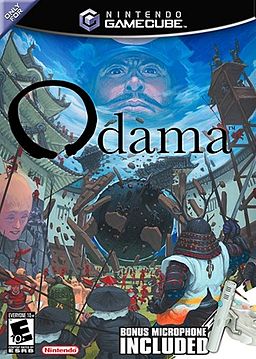- Odama
-
Odama 
North American box artDeveloper(s) Vivarium Publisher(s) Nintendo Designer(s) Yoot Saito Platform(s) Nintendo GameCube Release date(s) - PAL March 31, 2006
- NA April 10, 2006
- JP April 13, 2006
Genre(s) Pinball, real-time tactics Mode(s) Single-player Rating(s) Media/distribution 1 GameCube Optical Disc Odama (大玉 Ōdama, lit. "Great Ball") is a video game for the Nintendo GameCube developed by Vivarium and published by Nintendo in 2006. The game was designed by Seaman creator Yoot Saito.
Odama blends tactical wargaming with pinball gameplay. The game takes place in a feudal Japan setting. The main character is a young general named Yamanouchi Kagetora, who is intent on avenging his father's death by reviving the most ingenious weapon ever to hit the medieval battlefield: the Odama. The Odama is a gigantic ball powerful enough to destroy whatever it strikes, friend or foe. Using giant flippers, players aim the Odama to bowl over enemies, shatter their defenses and wreak havoc on the battlefield. With the Nintendo GameCube Microphone, players direct their soldiers out of the Odama's way and into the fray by charging the enemy, defending positions and seizing the enemy gates.
Contents
Plot
The main character in Odama is Yamanouchi Kagetora, a young general struggling to avenge his clan and preserve the Way of Ninten-do, which is a philosophy that means "The way of heavenly duty". With this philosophy to guide him, he finds that his individual soldiers can band together to create a force strong enough to defeat even the most powerful enemy, a general named Karasuma Genshin. Genshin betrayed Lord Yamanouchi Nobutada, Kagetora's father, in a coup, leading Lord Nobutada to take his own life in order to avoid the shame of defeat. Kagetora exacts his revenge, using only limited resources against a vast army. One of these resources is a sacred object protected by his clan: a legendary weapon called the Odama.
Gameplay
The player controls flippers, which operate exactly like those in a pinball game: they strike the Odama back into the battlefield, directing it into targets and away from soldiers. Between the two flippers, the commander stands guard, hacking down any soldiers who attempt to pass. Players can tilt the battlefield, allowing them to alter the course of the Odama. The goal is to shatter the enemy gates with the Odama and direct a crew of men carrying a giant bell to pass through the opened gates. Players' soldiers will defend their crew and seize enemy positions to protect their men on the mission.
The Nintendo GameCube Microphone included with the game is the most important addition to this title. Using the Microphone, players direct soldiers by giving voice commands. There are 11 commands, ranging from generic (moving left and right, advancing and retreating) to map-specific and special moves.
Development
Odama was developed by Vivarium and chiefly designed by Yoot Saito, the creator of Seaman for the Dreamcast.[1][2] According to Nintendo producer Shigeru Miyamoto, the publisher was initially taken aback by the game's curious mix of pinball and real-time tactics and Saito's initial pitch, "I want to make a pinball game set in feudal Japan." However, Saito eventually convinced them after creating a demo of the game.[1]
Odama debuted at the Electronic Entertainment Expo (E3) in 2004. This version of the game showcased the use of the DK Bongos, which allowed a second player to raise troop morale and distract enemy troops by repeatedly beating the drums.[3] However, this feature was absent from its E3 showing the next year and dropped prior to the game's release.[2]
Reception
Most critics did not like the short lifespan, poor graphics and difficulty of this game, yet generally praised the attempt at gameplay innovation. Netjak referred to it as "the third-best console game that involves rolling a giant ball over people."[4]
However, many believe the game's generally average critical response,[5] especially with regard to common criticism of the relatively high difficulty level, is unjust. For example, Spong wrote, "Show Odama the dedication that those games required back in the day, and its complicated gameplay will eventually become second nature..."[6], referring to the often more unforgiving computer and arcade games of the 1980s. Gamer7 wrote, "Odama’s difficulty level is admittedly extremely high by current standards, but by more traditional standards, it's a walk over."[7]
Odama won IGN's Most Innovative Design for a GameCube game in 2006.[8]
References
- ^ a b Gibson, Ellie (January 6, 2006). "Miyamoto talks Odama". Eurogamer. http://www.eurogamer.net/articles/news060106miyamoto. Retrieved 2011-05-01.
- ^ a b Dormer, Dan (January 13, 2006). "Odama Gets Release Date". 1UP.com. http://www.1up.com/do/newsStory?cId=3147048. Retrieved 2008-08-17.
- ^ IGN Staff (May 11, 2004). "E3 2004: Odama Unveiled". IGN. http://cube.ign.com/articles/513/513775p1.html. Retrieved 2011-05-01.
- ^ "Odama - GameCube review". http://web.archive.org/web/20081006000950/http://www.netjak.com/review.php/1153.
- ^ "Odama (cube: 2006): Reviews". http://www.metacritic.com/games/platforms/cube/odama.
- ^ "Odama (GameCube) - Review". http://spong.com/detail/editorial.jsp?eid=10109374&cid=&tid=&pid=&plid=&page=2.
- ^ "Gamer computer gaming motherboards 360 at gamer7.com". http://gamer7.com/modules/reviews/article.php?articleid=58.
- ^ "GameCube: Most Innovative Design". IGN. 2006. http://bestof.ign.com/2006/cube/31.html. Retrieved 2008-06-10.
External links
- Official website (Japanese)
- Odama at GameRankings
- Odama at IGN
Categories:- 2006 video games
- Nintendo GameCube games
- Nintendo GameCube-only games
- Nintendo GameCube microphone games
- Microphone-controlled computer games
- Pinball video games
- Real-time tactics video games
- Video games set in Feudal Japan
Wikimedia Foundation. 2010.
